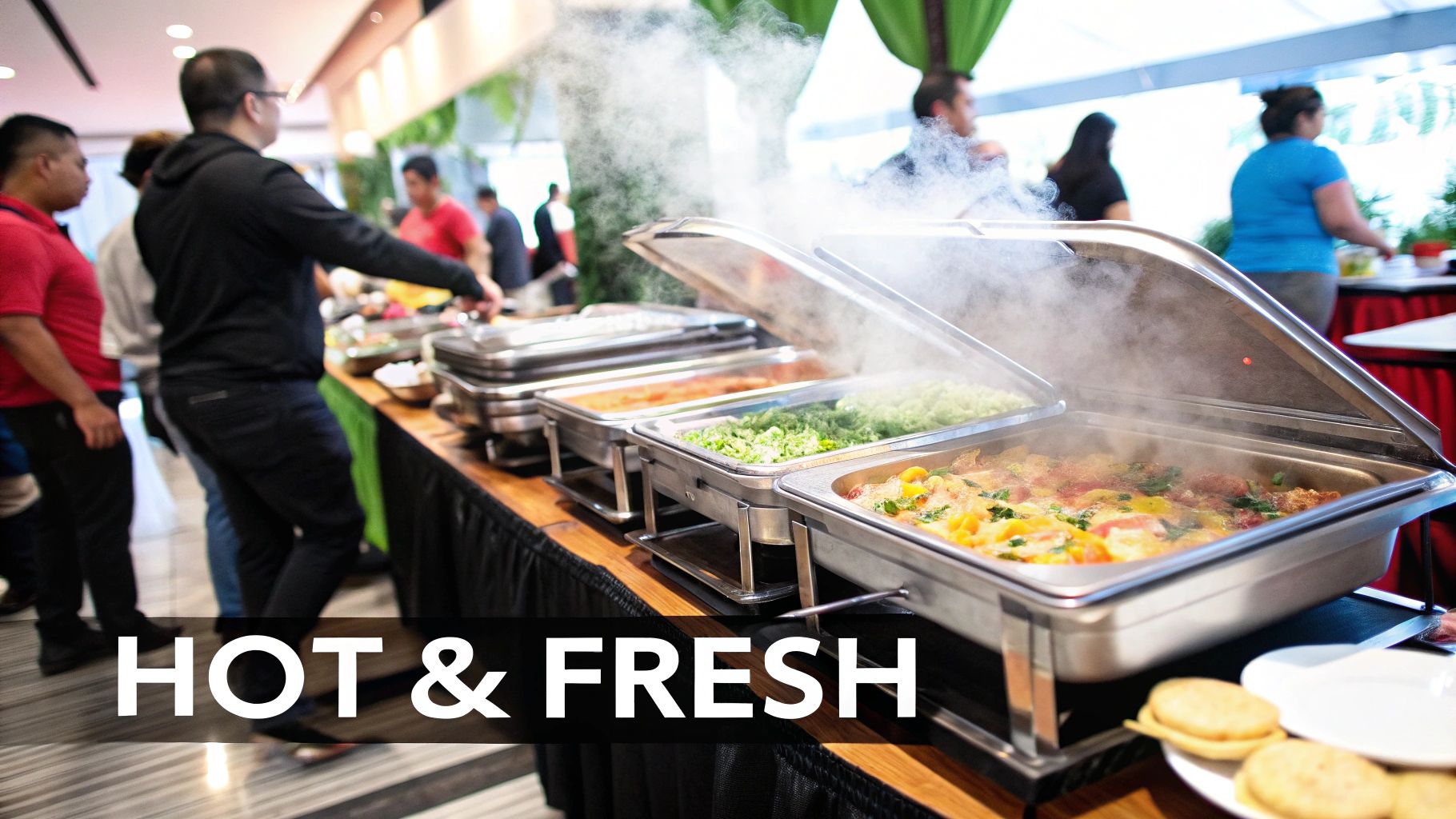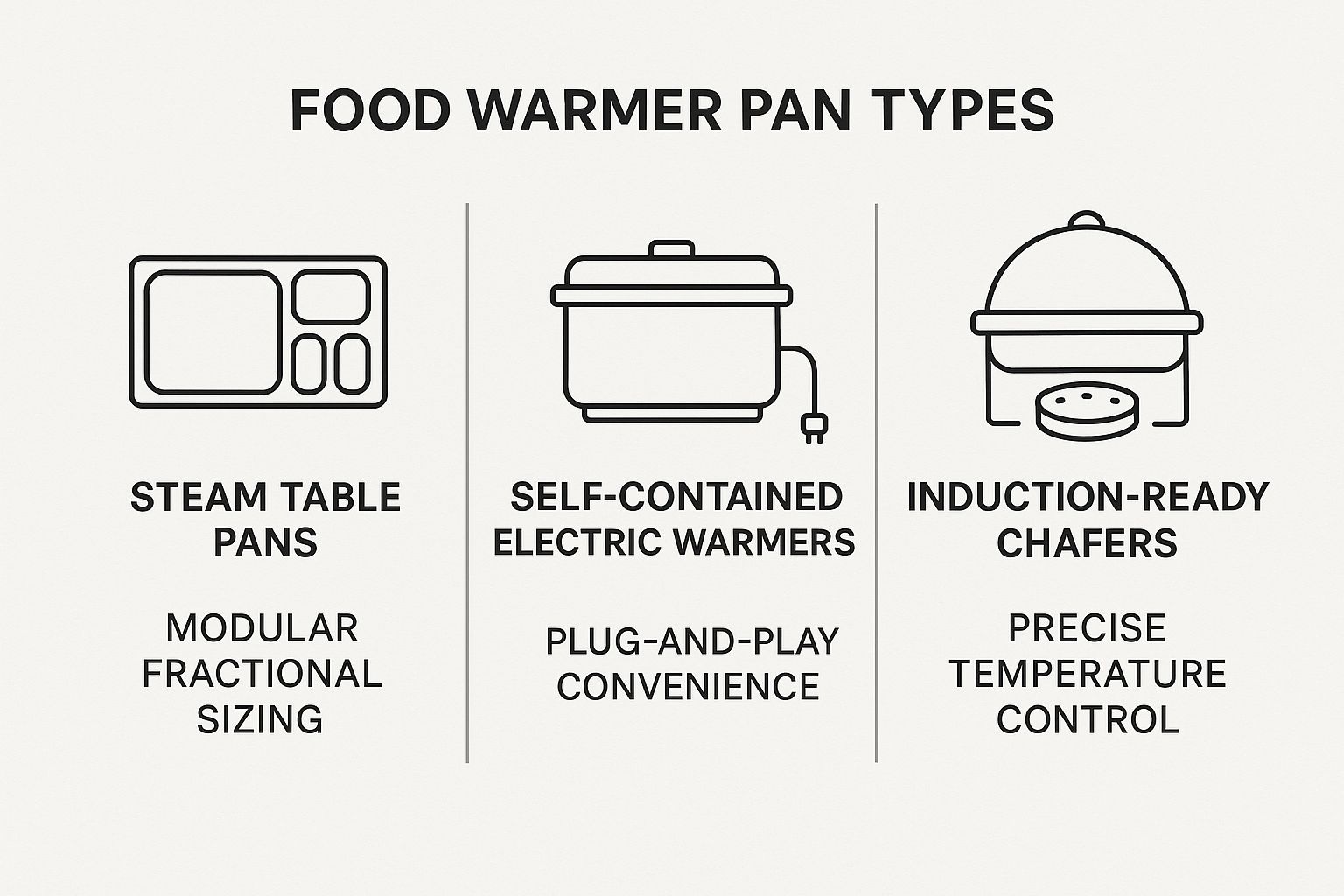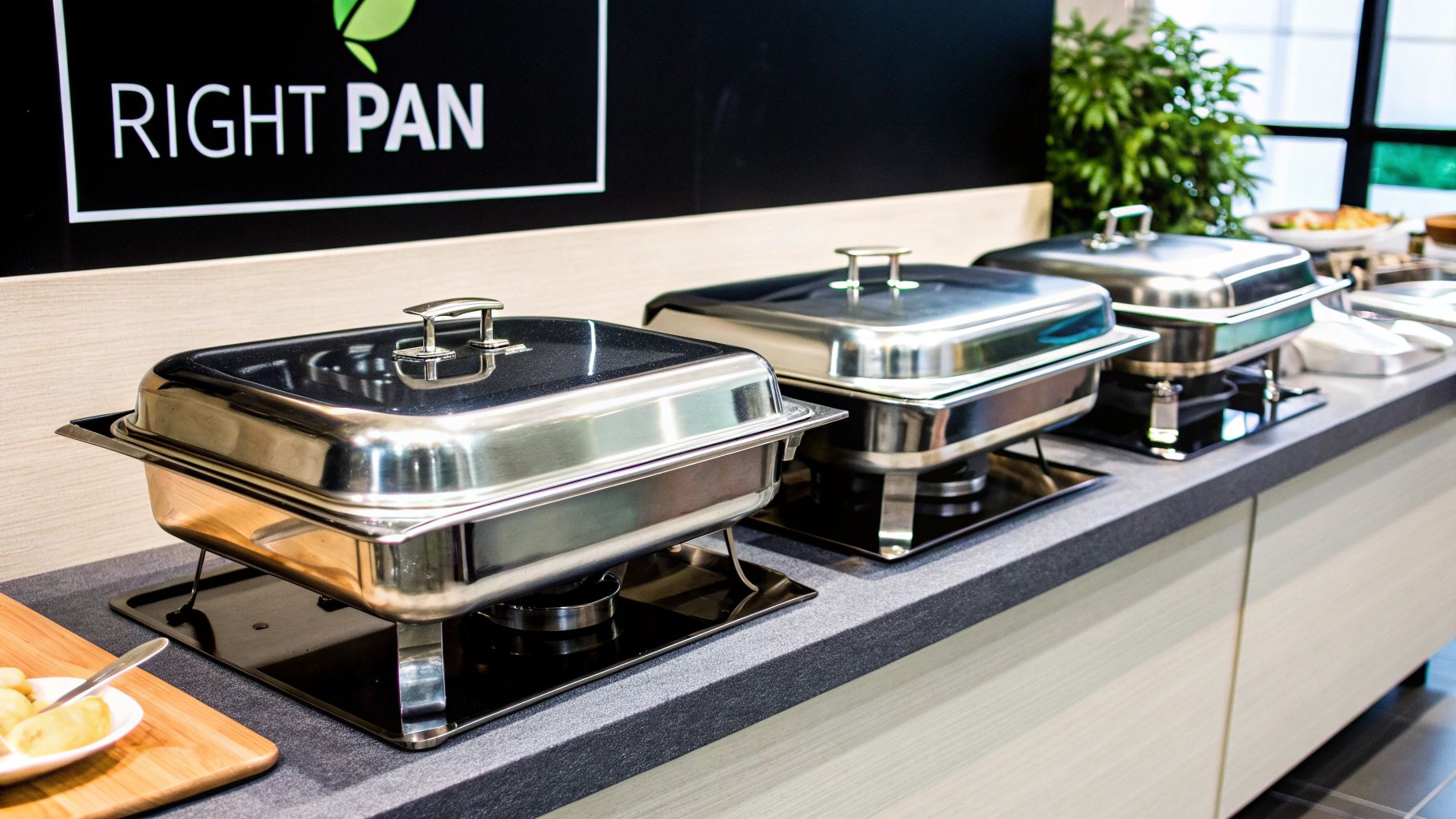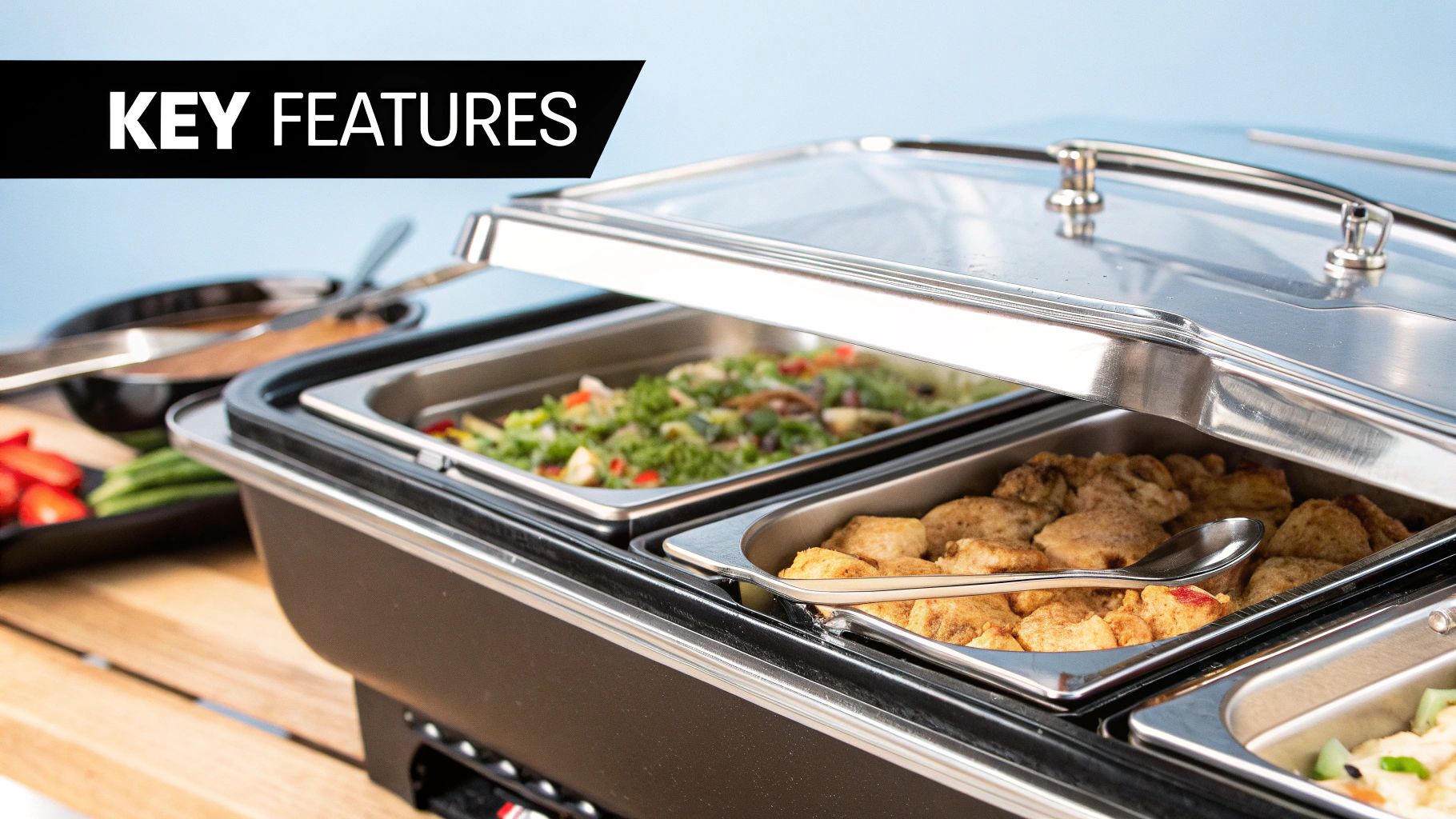
Your Guide to Commercial Griddles
Ever been to a diner and wondered how they get that perfect, crispy sear on a burger or those fluffy, golden-brown pancakes every single time? It's not magic. It’s the hard work of commercial griddles. These workhorse cooktops are the unsung heroes of the food service world, built specifically to cook food with a safe, consistent, and appetizing heat.
What Are Commercial Griddles

You might know them as flat-top grills, but whatever you call them, they act as the crucial bridge between your raw ingredients and your customer's plate. Let's be clear: these surfaces are for cooking, not just holding. Their job is to transfer heat efficiently to cook everything from eggs and bacon to cheesesteaks and vegetables, maintaining a precise temperature across the cooking surface.
This simple function is what allows kitchens to produce high volumes of food quickly and consistently. More than that, it's what creates the Maillard reaction—that browning process that develops the deep, savory flavors and textures customers crave.
For any business that serves breakfast, lunch, or dinner, these cooktops are non-negotiable. Think sprawling diner kitchens, busy food trucks, or even the hot line at a steakhouse. They ensure the last person in line gets a meal that’s just as perfectly cooked as the first. You really can't overstate their role in maintaining food quality.
The Growing Importance of Griddle Cooking
It’s no surprise that the market for this kind of equipment is getting bigger. It just shows how vital proper griddle cooking has become for running a successful kitchen and keeping customers happy. The global commercial cooking equipment market, which includes commercial griddles, continues to expand as restaurants seek efficiency and consistency. One report valued the broader food service equipment market at over $34 billion and expects significant growth. You can read more about these market trends on imarcgroup.com.
This guide is your complete resource for mastering griddle cooking. We’re going to walk through everything, including:
- The different types of griddles and what they’re used for.
- How to pick the right materials and sizes for your menu.
- The key features you should look for before you buy.
- Simple tips for use and maintenance to make your griddle last.
Once you know how to choose and use a griddle correctly, you’ll be able to step up your service, lock down food quality, and make your entire kitchen run more smoothly.
Navigating the Types of Commercial Griddles
Think of commercial griddles as specialized tools in your kitchen arsenal. You wouldn't use a small sauté pan for a banquet, and you wouldn't use the same type of griddle for every dish on your menu. Each one is built for a specific job, making sure your food comes off the line with perfect color and temperature.
The undisputed champion of diners and high-volume kitchens is the standard flat-top griddle. These stainless steel workhorses are the foundation of any flexible cooking line. Their real genius is in their simplicity and versatility—you can cook a huge variety of items simultaneously, from pancakes to burgers, giving you a totally custom workflow. It’s a simple way to offer more variety without needing more space.
The Power of Temperature Control
The griddle system is basically like having a massive, single-zone or multi-zone pan. You get to control the heat to create the perfect cooking environment for your menu.
- Manual Griddles: These are your go-to for simple, high-heat applications. They are durable and straightforward, perfect for kitchens that cook a limited menu.
- Thermostatic Griddles: Perfect for menus requiring precision. You can set specific temperatures and the griddle will maintain them, ensuring consistent results for delicate items like eggs or fish.
- Clamshell Griddles: This is how you build an impressive, high-speed production line. By cooking from both the top and bottom simultaneously, you can slash cook times for items like burgers and chicken breasts.
This infographic gives you a quick visual breakdown of the main categories of cooking equipment.

As you can see, each style has its own sweet spot, from the versatile flat-top to the high-tech precision of specialized units.
Gas, Electric, and Specialized Griddles
Once you move past the standard controls, you'll need to choose a power source. Gas griddles are incredibly responsive—turn the knob and you get instant heat. This makes them ideal for kitchens that need to adjust temperatures on the fly. In a way, they operate a lot like other powerful gas cooking appliances, giving you targeted heat exactly where you need it. If you're looking for other countertop heating options, you can check out different commercial hot plates to round out your equipment.
Finally, we get to the newest player in the game: the induction griddle. This isn't just a small step up; it's a major leap forward in how we apply heat to a cooking surface.
Induction cooking works by using a magnetic field to generate heat directly in the griddle plate itself. This approach is incredibly efficient and gives you ridiculous temperature control, often staying within just one or two degrees of your set point.
That kind of precision is a lifesaver for delicate foods. Think perfectly seared scallops that aren't overcooked, or omelets that never brown. A small temperature swing can ruin these items, but induction keeps them flawless. While the upfront cost is a bit higher, the boost in food quality and energy savings makes induction griddles a smart investment for high-end operations that refuse to compromise. Knowing the strengths of each of these types lets you pick the perfect griddle for every single dish you serve.
Choosing the Right Griddle Material and Size

Picking the right material and size for your commercial griddle is just as important as choosing quality ingredients for your signature dish. Get it wrong, and you could be dealing with poor heat retention, hot spots, or a cooktop that just doesn't fit your menu. Think of it like casting an actor for a movie role—the material has to perform under the bright lights, and the size determines how much of the scene it commands.
Griddle Plate Materials: The Industry Standard
When it comes to the daily grind of a commercial kitchen, you'll find two main players for griddle plates: steel and chrome. Each has its place, and knowing the difference is key.
Standard steel is the undisputed workhorse of the industry. It’s tough, seasons well to develop non-stick properties, and transfers heat powerfully. A good steel griddle plate is also highly durable, which means it won’t warp or crack under the stress of rapid temperature changes.
On the other hand, chrome griddle plates are the champions of presentation cooking and delicate items. They transfer less radiant heat, which means a cooler kitchen, and their mirror-like surface is easy to clean. The trade-off? Chrome requires non-metal utensils to avoid scratching the surface.
To make the choice clearer, let's break down the common materials you'll encounter.
Commercial Griddle Plate Material Comparison
| Material | Best For | Pros | Cons |
|---|---|---|---|
| Steel | All-purpose griddling for high-volume items like burgers, bacon, and cheesesteaks | Extremely durable, excellent heat retention, seasons over time for better performance | Slower to heat up, requires regular seasoning, transfers more ambient heat |
| Chrome | Delicate items like eggs and fish; open kitchens where appearance matters | Excellent non-stick properties, easy to clean, highly energy efficient, less radiant heat | Higher initial cost, requires special utensils to prevent scratching |
| Composite | Specialized applications requiring uniform heating | Superior heat distribution, durable | Can be more expensive, less common than steel or chrome |
| Cast Iron | High-heat searing and classic diner cooking | Unmatched heat retention, develops a natural non-stick surface | Heavy, requires meticulous seasoning, can rust if not maintained |
While you might see some specialty surfaces, market trends show that steel plates are still the top choice for busy kitchens. If you want to dive deeper, you can discover more market insights about food warming trays at archivemarketresearch.com. The bottom line is, for reliability and performance in high-volume cooking, steel wins out.
A Smart Sizing Strategy for Your Menu
Choosing a griddle size isn't just about finding something that fits. It's a strategic move that affects workflow, ticket times, and the variety you can offer your customers. Putting a slow-moving side item on a massive 72-inch griddle is a recipe for wasting energy and space.
A smart sizing strategy involves matching the griddle's depth and width to your menu's peak volume. For every 12 inches of griddle width, you can typically cook 8-10 burgers at once. Knowing your output needs prevents bottlenecks and wasted energy.
This modular thinking is what makes a cook line efficient. A 36-inch griddle is perfect for a small café, while a 72-inch model can anchor a high-volume diner. For menus with diverse temperature needs, consider a griddle with multiple thermostatic zones. This gives you the flexibility to sear steaks on one side while gently warming buns on the other.
Ultimately, matching the griddle size to your menu's demands is just good business. It keeps food moving, reduces ticket times, and makes your entire setup run a whole lot smoother.
Key Features Every Buyer Should Consider

Once you’ve settled on the right type and material for your commercial griddle, the real difference-makers are in the details. These features might seem small, but they’re what separate a workhorse piece of equipment from something you'll be looking to replace in a year.
Think of it like this: these features directly impact how easy the griddle is to use, how long it'll last, and ultimately, the quality of the food you serve. This is your checklist for making a smart investment.
A great place to start is the griddle plate's thickness—a simple measurement of its mass. Here's the trick: a thicker plate means better heat retention. A tough 1-inch thick plate will resist temperature drops when you add cold food, ensuring a consistent sear far better than a flimsy 1/2-inch one.
Splash Guards and Advanced Controls
The splash guard design is one of those things you don't think about until you're in the middle of a chaotic dinner rush. Choosing the right one can genuinely make your service cleaner and safer.
- Tapered Splash Guards: These are welded around the sides and back to contain grease splatter, keeping surrounding areas clean.
- High Splash Guards: A must-have for operations cooking high-fat items like bacon and burgers. They provide extra protection for staff and equipment.
- Grease Troughs: These are a game-changer. A wide, well-placed trough at the front of the griddle makes it easy to scrape grease and debris away, keeping the cooking surface clean.
Beyond the plate itself, modern griddles bring some serious tech to the table. Digital temperature controls offer a level of precision that old-school manual dials just can't touch. It’s the core feature of a high-end thermostatic griddle, where a few degrees can make or break a dish. Some units even feature programmable timers and multiple cooking zones.
The Non-Negotiable Certification
Finally, let's talk about the one feature that is absolutely non-negotiable: NSF certification.
Seeing that NSF (National Sanitation Foundation) International mark on a griddle is your guarantee that it's been rigorously tested to meet strict public health and safety standards.
An NSF-certified griddle is your assurance that it's made from food-safe materials, designed for easy cleaning, and built to prevent bacteria from hiding in cracks or crevices. In any professional kitchen, this isn’t a nice-to-have; it's a must-have for compliance and safety.
The market for commercial cooking equipment is always moving, with top brands competing on details like energy efficiency and smart controls. By paying attention to these key features, you ensure you're getting a product that not only works well but is also safe, durable, and built for the realities of a commercial kitchen.
Best Practices for Use and Maintenance
Buying a high-quality commercial griddle is a great start, but it's only half the job. To truly get your money's worth, you need solid techniques and a consistent care routine. Getting this right means your food is cooked safely, consistently, and with great flavor from the moment service starts until the last customer is served.
The single most important step? Seasoning and Preheating. Never put cold food on a cold griddle. It's a recipe for sticking and steaming, forcing your griddle to work overtime and killing any chance of a good sear.
Always bring your griddle up to temperature before the first order comes in. For steel plates, proper seasoning with oil creates a natural non-stick surface that improves with every use. This ensures the griddle is ready to cook efficiently, not fighting to recover heat. It's a simple, non-negotiable step that protects both food quality and the griddle surface.
Mastering Daily Operations
Beyond preheating, a few simple habits during service can make a huge difference. These are the little things that prevent common headaches on the cook line.
- Keep an Eye on Your Zones: For griddles with multiple controls, know your hot and cool zones. Use the hottest areas for searing and the cooler spots for finishing or holding.
- Scrape As You Go: Don't let food debris and grease build up. Use a griddle scraper frequently throughout service to keep the surface clean. This prevents carbon buildup and flavor transfer between items.
- Don't Overcrowd the Surface: I know it's tempting to fill every inch of the griddle, but it's a classic mistake. When you pack food on too tightly, the surface temperature drops and food steams instead of sears. You're much better off cooking in smaller batches to maintain that critical surface temperature.
We see it all the time in busy kitchens: griddles packed so tight there's no room to breathe. Doing this can slash surface temperature by as much as 50°F, creating major inconsistencies and a real food quality risk. A little space makes a big difference.
Nailing these simple steps will not only keep your food in perfect condition but will make your entire service run that much smoother.
Cleaning and Storage for Longevity
Proper maintenance is what separates the griddles that last for years from the ones you have to replace every season. A steel griddle plate is tough, but it's not invincible—it needs the right care to avoid issues like pitting or rust. Once service is done, scrape the surface clean while it's still warm (but not scorching hot).
When it's time to clean, use a griddle brick or non-abrasive pad with a bit of oil. Harsh chemicals or excessive water can strip the seasoning you've worked so hard to build. If you've got stubborn, baked-on food, a good scrape followed by a light re-seasoning is the best approach. This gentle approach is key for all sorts of kitchen gear; you can see similar advice in many guides on equipment care.
Finally, protect the surface overnight. After cleaning, apply a very thin coat of cooking oil to the steel surface. This prevents rust from forming and keeps your commercial griddle in fighting shape for years of reliable service.
Your Commercial Griddle Questions Answered
No matter how dialed-in your kitchen is, questions pop up during the chaos of service. Getting a straight answer fast can be the difference between a smooth rush and a costly mistake. Let's tackle some of the most common questions we hear from chefs and managers about their commercial griddles.
Can You Use a Griddle for Holding Food?
Let's make this crystal clear: not for long-term holding. This is one of the biggest food safety rules in the kitchen. A griddle is designed for cooking food to a safe internal temperature, not holding it for extended periods.
They produce intense, direct heat that will continue to cook the food, eventually drying it out or burning it. If you need to hold food, it must be transferred to proper holding equipment that keeps it above the "danger zone" (40°F to 140°F) without overcooking it.
Think of it like this: A griddle is a sprinter, not a marathon runner. Its job is to cook food fast and efficiently. Trying to use it for holding is a gamble with your food quality that you never want to take.
What's the Difference Between a Griddle and a Grill?
This one trips a lot of people up, but it's actually simple: the surface. They are both used for cooking, but they transfer heat in different ways.
- Griddle: This is a flat, solid cooking surface. It cooks food via direct contact (conduction) and is perfect for small or liquid items like eggs, pancakes, and chopped vegetables.
- Grill: This has raised grates with open spaces in between. It cooks food with a combination of conduction (where the grates touch) and radiant heat, creating characteristic grill marks.
So, a griddle gives you an even, all-over sear, while a grill provides a charred, smoky flavor and distinct markings. That same griddle cooking burgers could be right next to a charbroiler finishing steaks.
How Do I Keep Food From Sticking to a Griddle?
Ah, the eternal struggle of the service line. Preventing sticking is all about temperature control and proper seasoning. Your number one tool is a well-seasoned steel surface—it creates a natural, non-stick layer.
Before cooking, ensure your griddle is fully preheated. Placing food on an underheated surface is a primary cause of sticking. Use enough fat, like oil or clarified butter, to create a barrier between the food and the steel. For delicate items like fish or eggs, a clean surface is paramount—scrape away any debris from the previous item before you start cooking.
What Does the Thickness of a Griddle Plate Mean?
The plate thickness tells you how much steel is in the cooking surface. It's a direct indicator of performance: a thicker plate means better heat retention and faster recovery.
A 1-inch thick plate, for example, is much better at holding its temperature when a rush of frozen burger patties hits it compared to a thinner 1/2-inch plate. For any serious commercial kitchen, spending a little extra on a thicker griddle plate is a no-brainer. They resist temperature fluctuations, cook more evenly, and will simply perform better under pressure.
At Griddles.com, we get what it takes to run a professional kitchen. Check out our complete lineup of tough, reliable commercial cooking equipment built to handle the daily grind and keep your service running like clockwork.
